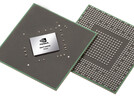NVIDIA GeForce 840M vs Intel HD Graphics 5500
NVIDIA GeForce 840M
► remove from comparison
The NVIDIA GeForce 840M is a mid-range DirectX 12-compatible graphics card for laptops unveiled in March 2014. It is one of the first cards based on Nvidia's new Maxwell architecture (GM108 chip), but is still manufactured in 28 nm. The 840M offers 384 shader units clocked at 1029 MHz (+ Boost) as well as 2 GB of DDR3 memory (64 bit, 2000 MHz effective).
Architecture
Compared to Kepler, Maxwell has been optimized in several details to increase power efficiency. Smaller Streaming Multiprocessors (SMM) with only 128 ALUs (Kepler: 192) and an optimized scheduler should lead to better utilization of the shaders. Nvidia promises that a Maxwell SMM with 128 ALUs can offer 90 percent of the performance of a Kepler SMX with 192 ALUs. GM108 features 3 SMMs and thus 384 shader cores, 24 TMUs and 8 ROPs (64-bit interface).
Another optimization is the massively enlarged L2 cache. The larger size can process some of the memory traffic to allow for a relatively narrow memory interface without significantly reducing performance.
Similar to Fermi and Kepler, the GM107/GM108 support DirectX 12 with feature level 11_0 only.
Performance
According to our benchmarks, the GeForce 840M is about 30 percent faster than the old GT 740M and just slightly behind a GeForce GT 750M (DDR3 version). Many games of 2013/2014 can be played fluently in WXGA resolution (1366 x 768) and medium or high detail settings. However, very demanding games such as Crysis 3 or Battlefield 4 will require lower resolutions and/or details.
Features
GM108 integrates the sixth generation of the PureVideo HD video engine (VP6), offering a better decoding performance for H.264 and MPEG-2 videos. Of course, VP6 supports all features of previous generations (4K support, PIP, video encoding via NVENC API). Unfortunately, HDMI 2.0 is still not supported.
Power Consumption
The power consumption of the GeForce 840M should be about 30 Watts or lower. Therefore, the GPU is best suited for laptops 13 - 14 inches in size and above. The 800M series also supports Optimus to automatically switch between an integrated graphics card and the Nvidia GPU.
Intel HD Graphics 5500
► remove from comparison
The Intel HD Graphics 5500 (GT2) is an integrated Broadwell graphics card revealed in Q1 2015. It can be found in several ULV SoCs (15 W TDP) such as the Core i5-5200U or i7-5600U. While Core i5 and Core i7 chips feature 24 EUs, the Core i3 version offers just 23 EUs. Depending on the specific CPU, the maximum GPU frequency varies between 850 and 950 MHz.
Architecture and Features
Broadwell features a GPU based on the Intel Gen8 architecture, which has been optimized in various aspects compared to the previous Gen7.5 (Haswell). Inter alia, the shader arrays called "subslice" have been reorganized and now offer 8 Execution Units (EUs) each. Three subslices form a "slice" for a total of 24 EUs. Combined with other improvements such as larger L1 caches and an optimized frontend, the integrated GPU has become faster and more efficient than its predecessor.
The HD Graphics 5500 represents the mid-range version of the Broadwell GPU family and consists of one slice with 24 EUs. Beyond that, there is also a low-end variant (GT1, 12 EUs) as well as higher-end models (GT3/GT3e + eDRAM, 48 EUs).
All Broadwell GPUs support OpenCL 2.0 and DirectX 12 (FL 11_1). The video engine can now decode H.265 using both fixed function hardware as well as available GPU shaders. Up to three displays can be connected via DP 1.2/eDP 1.3 (max. 3840 x 2160 @ 60 Hz) or HDMI 1.4a (max. 3840 x 2160 @ 24 Hz). HDMI 2.0, however, is not supported.
Performance
Depending on the specific CPU, the maximum GPU frequency varies between 850 and 950 MHz. Due to the low TDP, however, the average clock in 3D applications will be somewhat lower.
Equipped with fast dual-channel memory, the HD Graphics 5500 outperforms the HD Graphics 4400 (Haswell, 20 EUs) by 20 - 25 percent and also beats the HD Graphics 5000 (Haswell, 40 EUs). However, even a low-end dedicated GeForce 820M ist about 10 - 30 percent faster than the HD 5500. Games as of 2014/2015 will usually run fluently only at (very) low settings.
Power Consumption
Utilizing a new 14 nm process, the Broadwell ULV chips are specified at just 15 W TDP and therefore suited for thin ultrabooks. The TDP is flexible and can be further reduced (7.5 or 10 W), which has a significant impact on performance.
| NVIDIA GeForce 840M | Intel HD Graphics 5500 | |||||||||||||||||||||||||||||||||||||||||||||||||||||||||||||||||||||||||||||||||||||
| HD Graphics Series |
|
| ||||||||||||||||||||||||||||||||||||||||||||||||||||||||||||||||||||||||||||||||||||
| Codename | N15S-GT | Broadwell GT2 | ||||||||||||||||||||||||||||||||||||||||||||||||||||||||||||||||||||||||||||||||||||
| Architecture | Maxwell | Gen. 8 Broadwell | ||||||||||||||||||||||||||||||||||||||||||||||||||||||||||||||||||||||||||||||||||||
| Pipelines | 384 - unified | 24 - unified | ||||||||||||||||||||||||||||||||||||||||||||||||||||||||||||||||||||||||||||||||||||
| Core Speed | 1029 MHz | 300 - 950 (Boost) MHz | ||||||||||||||||||||||||||||||||||||||||||||||||||||||||||||||||||||||||||||||||||||
| Memory Speed | 2000 MHz | |||||||||||||||||||||||||||||||||||||||||||||||||||||||||||||||||||||||||||||||||||||
| Memory Bus Width | 64 Bit | 64/128 Bit | ||||||||||||||||||||||||||||||||||||||||||||||||||||||||||||||||||||||||||||||||||||
| Memory Type | DDR3 | |||||||||||||||||||||||||||||||||||||||||||||||||||||||||||||||||||||||||||||||||||||
| Max. Amount of Memory | 4 GB | |||||||||||||||||||||||||||||||||||||||||||||||||||||||||||||||||||||||||||||||||||||
| Shared Memory | no | yes | ||||||||||||||||||||||||||||||||||||||||||||||||||||||||||||||||||||||||||||||||||||
| API | DirectX 12 (FL 11_0), Shader 5.0, OpenGL 4.5 | DirectX 12 (FL 11_1), OpenGL 4.3 | ||||||||||||||||||||||||||||||||||||||||||||||||||||||||||||||||||||||||||||||||||||
| technology | 28 nm | 14 nm | ||||||||||||||||||||||||||||||||||||||||||||||||||||||||||||||||||||||||||||||||||||
| Features | GPU Boost 2.0, Optimus, PhysX, CUDA, GeForce Experience, GameWorks | Quick Sync | ||||||||||||||||||||||||||||||||||||||||||||||||||||||||||||||||||||||||||||||||||||
| Notebook Size | medium sized | |||||||||||||||||||||||||||||||||||||||||||||||||||||||||||||||||||||||||||||||||||||
| Date of Announcement | 12.03.2014 | 05.01.2015 | ||||||||||||||||||||||||||||||||||||||||||||||||||||||||||||||||||||||||||||||||||||
| Link to Manufacturer Page | www.nvidia.de | |||||||||||||||||||||||||||||||||||||||||||||||||||||||||||||||||||||||||||||||||||||
| Transistors | 1.3 Billion |
| |||||||||||||||||||||||||
Benchmarks
3DM Vant. Perf. total + NVIDIA GeForce 840M
specvp11 snx-01 + NVIDIA GeForce 840M
specvp12 sw-03 + NVIDIA GeForce 840M
Cinebench R15 OpenGL 64 Bit + NVIDIA GeForce 840M
GFXBench T-Rex HD Offscreen C24Z16 + NVIDIA GeForce 840M
Average Benchmarks NVIDIA GeForce 840M → 100% n=37
Average Benchmarks Intel HD Graphics 5500 → 82% n=37
* Smaller numbers mean a higher performance
1 This benchmark is not used for the average calculation
Game Benchmarks
The following benchmarks stem from our benchmarks of review laptops. The performance depends on the used graphics memory, clock rate, processor, system settings, drivers, and operating systems. So the results don't have to be representative for all laptops with this GPU. For detailed information on the benchmark results, click on the fps number.

Hunt Showdown
2020
Escape from Tarkov
2020
Hearthstone
2020
Need for Speed Heat
2019
Borderlands 3
2019
The Division 2
2019
Dirt Rally 2.0
2019
Far Cry New Dawn
2019
Metro Exodus
2019
Apex Legends
2019
Just Cause 4
2018
Darksiders III
2018
Battlefield V
2018
Farming Simulator 19
2018
Fallout 76
2018
Forza Horizon 4
2018
Monster Hunter World
2018
The Crew 2
2018
X-Plane 11.11
2018
Call of Duty WWII
2017
The Evil Within 2
2017
Ark Survival Evolved
2017
Team Fortress 2
2017
Rocket League
2017
Resident Evil 7
2017
Titanfall 2
2016
Farming Simulator 17
2016
Battlefield 1
2016
Rainbow Six Siege
2015
Just Cause 3
2015
Fallout 4
2015
Anno 2205
2015
FIFA 16
2015
World of Warships
2015
Metal Gear Solid V
2015
Mad Max
2015
Dota 2 Reborn
2015
The Witcher 3
2015
Dirt Rally
2015
GTA V
2015
Battlefield Hardline
2015
Evolve
2015
The Crew
2014
Far Cry 4
2014
F1 2014
2014
The Evil Within
2014
Ryse: Son of Rome
2014
Alien: Isolation
2014
Fifa 15
2014
Sims 4
2014
Risen 3: Titan Lords
2014
GRID: Autosport
2014
Watch Dogs
2014
Titanfall
2014
Thief
2014
X-Plane 10.25
2013
Call of Duty: Ghosts
2013
Battlefield 4
2013
F1 2013
2013
Fifa 14
2013
Total War: Rome II
2013
Saints Row IV
2013
Company of Heroes 2
2013
Metro: Last Light
2013
BioShock Infinite
2013
SimCity
2013
Tomb Raider
2013
Crysis 3
2013
Dead Space 3
2013
Far Cry 3
2012
Assassin´s Creed III
2012
Hitman: Absolution
2012
Dishonored
2012
Borderlands 2
2012
Guild Wars 2
2012
Counter-Strike: GO
2012
Sleeping Dogs
2012
Max Payne 3
2012
Dirt Showdown
2012
Diablo III
2012
Risen 2: Dark Waters
2012
Mass Effect 3
2012
Alan Wake
2012
Anno 2070
2011
Battlefield 3
2011
Batman: Arkham City
2011
Dirt 3
2011
Mafia 2
2010
StarCraft 2
2010
Metro 2033
2010Average Gaming NVIDIA GeForce 840M → 100%
Average Gaming 30-70 fps → 100%
Average Gaming Intel HD Graphics 5500 → 48%
Average Gaming 30-70 fps → 52%
For more games that might be playable and a list of all games and graphics cards visit our Gaming List









































































